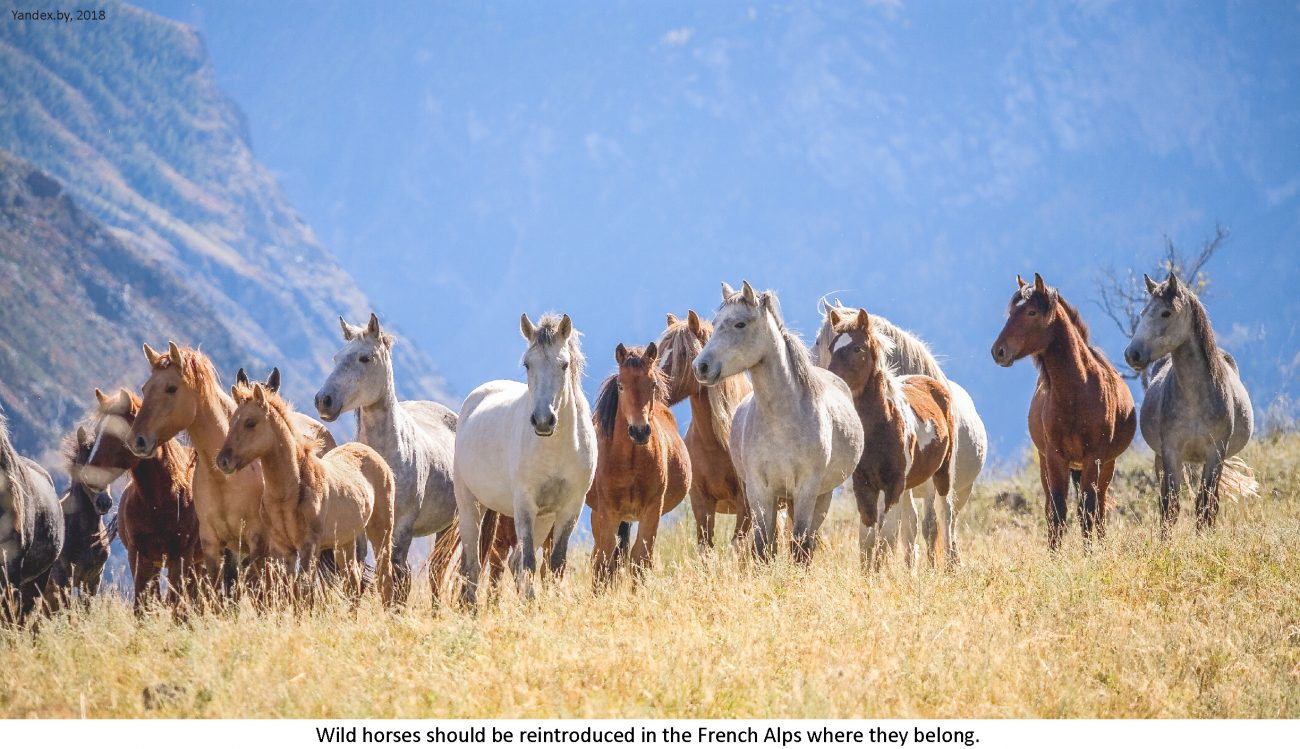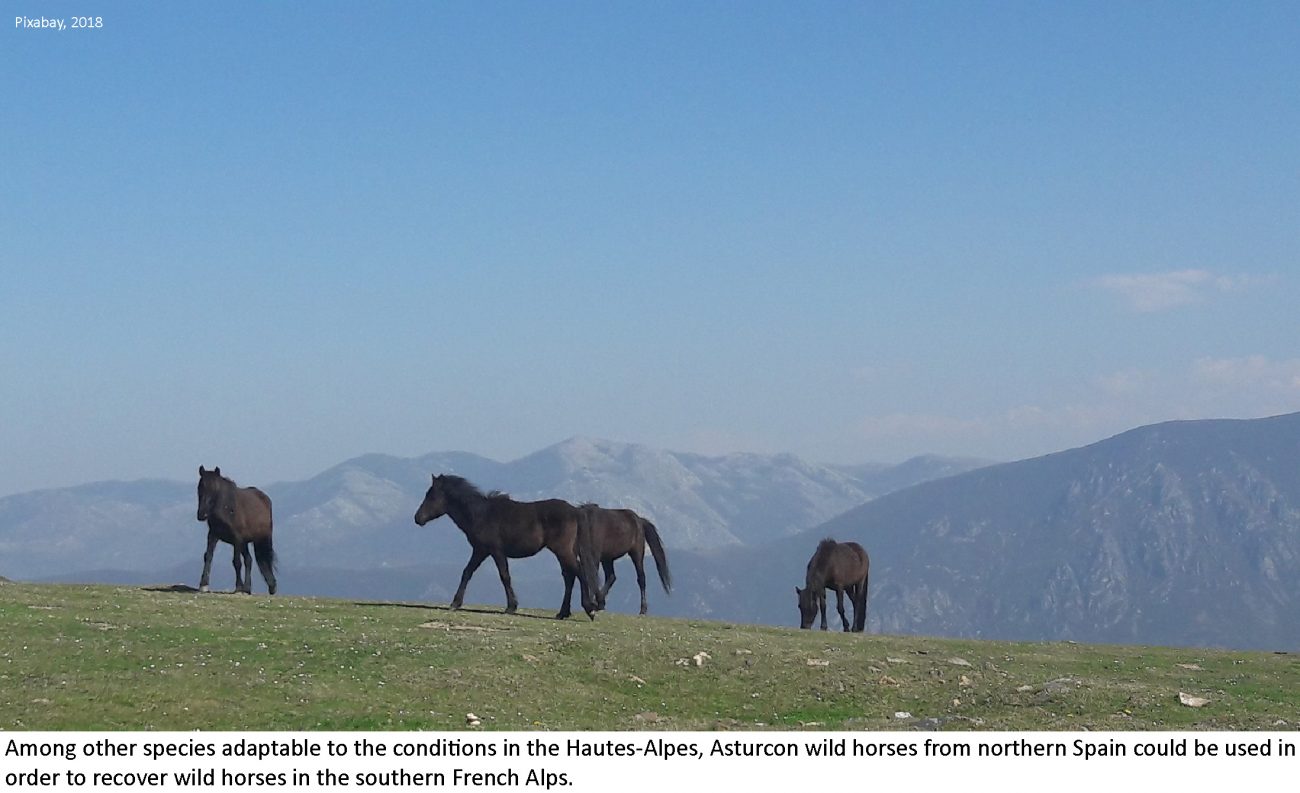Cars, sheep and large landowners: winning trio in the Hautes-Alpes (before hangover)
4. Unwelcomed wild migrants
In the Hautes-Alpes in southern France as in other parts of the world, one can always focus on environmental and social accomplishments: the adequate protection of certain wildlife species; the welcoming of foreign migrants within organized groups and families; the efforts made by small farmers and consumers to sustain organic farming; the collection and treatment of compost at the municipal level; etc. But the scope of these accomplishments remains limited. They are never part of a lifestyle that could be considered truly balanced from economic and environmental standpoints. We don’t need to impose this lifestyle on others, but we need to be able to lead it without obstacles put in our way by hateful opponents. Prevailing trends, namely the immense social inequity rooted in our economic and legal systems and environmental mismanagement, stand in our way. In order to liberate people who want it from these scourges, we have to identify and explain them as clearly as possible. It helps us minimize cooperation with the insane established order and implement solutions consistent with both our needs as human beings and the needs of our environment. These are the two goals of this series of articles on the Hautes-Alpes.
1. Driving safely towards global warming
3. The lowness of large landowners on top of the Hautes-Alpes (courtesy of French legislators)
Subscribe to my newsletter
Buy PDF of part 4 (€ 2.00)
Buy eBook (.epub and .mobi) of part 4:
Hautes-Alpes - Part 4 (10/2018)
HIKING IN THE MOUNTAINS IN EARLY JUNE will give you a first glimpse of the problem. By day, even relatively common species like the chamois or Alpine ibex are rare, almost invisible. Early June is neither the peak tourist season nor a period of intensive sheep grazing in alpine meadows. During this time of the year, you can hike for days in subalpine forests and alpine meadows without spotting one chamois or Alpine ibex.
The potential habitat for wildlife is not scarce within the 5,550 km² of the Hautes-Alpes département. There is less than 5 inhabitants per square kilometer (inh./km²) in a big chunk of this area. Just to name a few vast and sparsely populated municipalities, Ceillac covers an area of 96 km² with 3 inh./km², Cervières 110 km² with 2 inh./km², Champoléon 99 km² with 1.5 inh./km², Fressinières 88 km² with 2.5 inh./km², Névache 191 km² with 2 inh./km², etc[1]. The Hautes-Alpes’ five biggest cities gather about half the département‘s 140,000 inhabitants (Briançon, Embrun, Gap, Laragne-Montéglin et Veynes). The geographic distribution of the population and its density are rather similar in the neighboring mountainous regions (Savoie, Alpes de Haute-Provence and the Italian Alps). Three-quarters of the Hautes-Alpes are covered with uninhabited forests (45 percent of which are public lands) and alpine pastures (87 percent public) (Agreste, 2010, p.3; IGN, 2015, p.7; Insee, 2016; Irstea et al., 2016).
Lots of Hauts-Alpins (inhabitants of the Hautes-Alpes) do not want wild animal species to reclaim available habitats. To be clear, these citizens do not want to make a serious effort to share available lands with wild animals, regardless of their position in the food chain. They show indifference, little sensitivity, or hostility towards the needs of wild animals. Political authorities are the best ally of these anthropocentric citizens. Most of the time, elected officials from the local to the national level support opinions detrimental to wildlife. So let’s begin with the number one « wild enemy ».
A martyr
Persecuted by the French State, most sheep and cattle producers as well as poachers (generally left alone by elected officials), the wolf is also despised or ignored by scores of citizens. As a consequence, this wild migrant must keep a low profile everywhere (photo 15). In France, the European gray wolves are denied populations compatible with local and regional ecosystem resources. No current French political party is willing to consider a balanced wolf management.
Photo 15
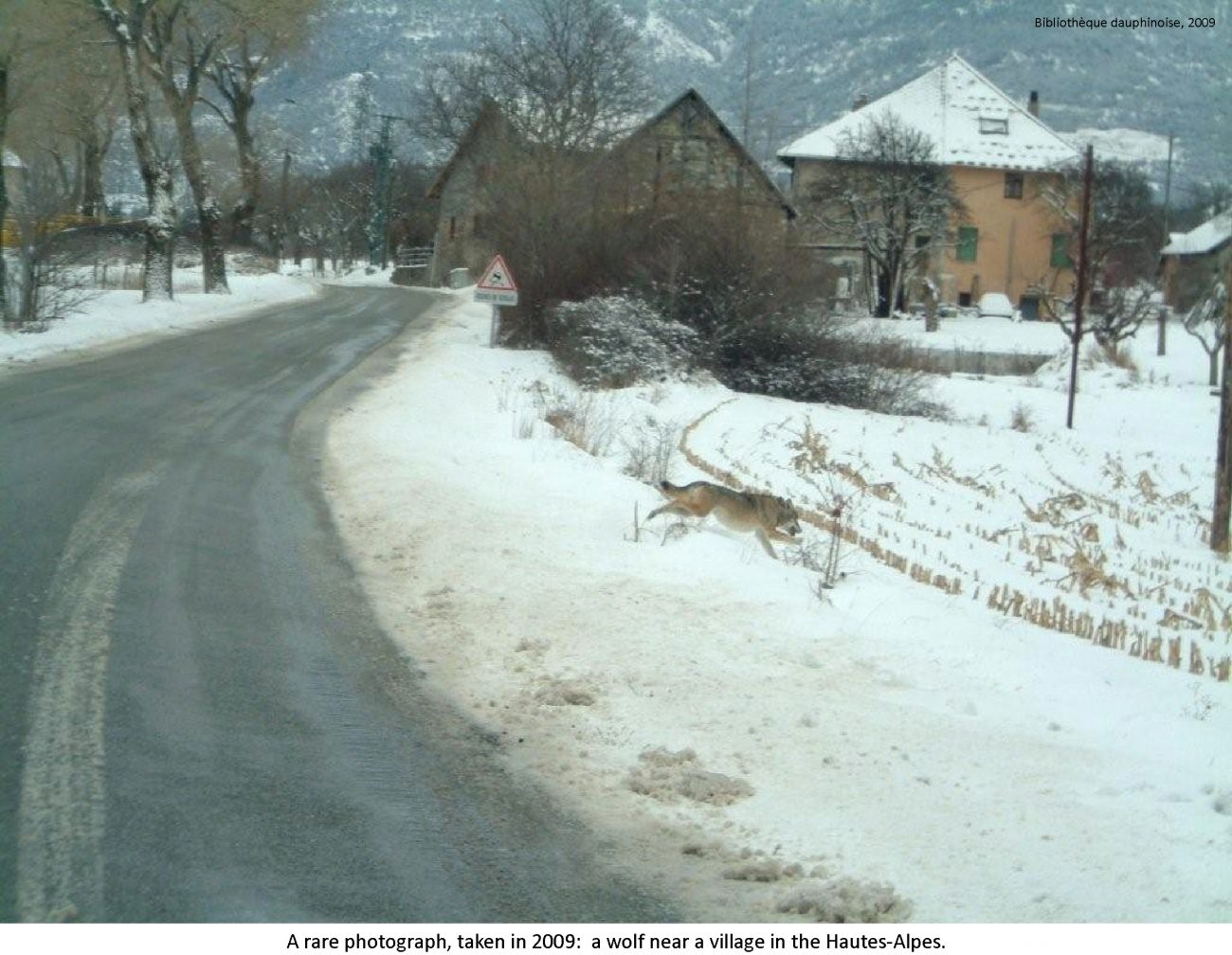 In other regions of the world, people are more tolerant of the wolf. Let’s look at a case in point in a region where I did my PhD research for three consecutive years. In some areas of the U.S. Northern Rocky Mountains, wolf attacks on sheep and cattle have recently collapsed. To get to this result, managers have taken several actions simultaneously:
In other regions of the world, people are more tolerant of the wolf. Let’s look at a case in point in a region where I did my PhD research for three consecutive years. In some areas of the U.S. Northern Rocky Mountains, wolf attacks on sheep and cattle have recently collapsed. To get to this result, managers have taken several actions simultaneously:
- The installation of electrified fences around sheep and cattle.
- Long red flags attached to these fences.
- More guard dogs and a greater surveillance by shepherds and livestock producers.
- Shots in the air and the use of firecrackers.
- Most importantly, a GPS tracking collar attached to one member of every wolf pack in a given area allows for real-time monitoring of the packs’ movements. So in this area, sheep and cattle can graze where attacks are most unlikely to occur (Barbier, 2014, p.446-448).
French decision-makers in wolf management have chosen to ignore this kind of experience. Their incompetence is scientific too. They do not care about the impact of wolves on the ecosystems that they inhabit. In the absence of in-depth study of this issue in Europe, the results of research undertaken in the United States are once again useful.
Before the reintroduction of the gray wolf in the Northern Rockies in 1996, riparian areas were commonly overgrazed by wild ungulates. For more than 20 years now, wolf packs have been roaming in the riparian areas of southwestern Montana and northwestern Wyoming. They have reduced the presence of wild ungulates in these areas and therefore their grazing. As a result, the riparian vegetation has recovered, which in turn has attracted beavers and different bird species. Moreover, since wolf packs have been back, coyotes and wild ungulates do not proliferate anymore. Wolves even improve the overall health of ungulate herds by eliminating their most fragile members. They also benefit birds of prey and scavengers that feed on carcasses left by wolves on the ground (Barbier, 2014, p.442-443).
By ignoring the role that wolves play in ecosystems, French governmental decision-makers (le ministre de la transition écologique et solidaire and employees of the ministère) eliminate both educative and profitable opportunities. Indeed, if wolf populations were consistent with ecosystem resources, wildlife viewing tours respectful of the predator would undoubtedly lure a lot of people.
Le ministère de la transition écologique et solidaire and field managers focus mostly on only one aspect of wolf management: wolf attacks on sheep and cattle. Between January 2016 and July 2017 in France as a whole, a total of 10,200 farm animals were confirmed killed by wolves. A great majority of them were sheep. Even in the Région Sud, which encompasses the Hautes-Alpes and where 7,200 sheep were killed in 2017, wolves took less than 0.9 percent of the regional sheep population estimated at 786,000. Sheep producers are well compensated. On average, the French government gives them 310 euros for any sheep killed by a wolf. It is more than its average market value (Agreste PACA, 2018, p.21; DREAL Auvergne-Rhône-Alpes, 2018 [a] et [b]; Enault et Rasplus, 2017; Mines-Paristech, 2013).
So the loss of cattle and sheep due to wolves is by no means important and the compensation program is good. Nonetheless, in 2018 the French government decided to kill more wolves in order to better protect farm animals. Although there are less than 400 wolves in France, the government decided to authorize the killing of 40 wolves per year until 2023. The inherently violent governmental management of the wolf is not going to stop anytime soon (Ministère de la transition écologique et solidaire, 2018, p.6, 11).
Other species do not get as much media coverage as the wolf does, but they deserve our tolerance and kindness. Very few Hauts-Alpins, let alone local elected officials, are ready to be that tolerant and kind. Otters, bears and wild horses are some of the species that have a rightful place here. I am not speaking about a symbolic presence similar to the bear in the Pyrénées mountains in southwestern France or salmon in the Loire river basin in central France. The efforts made to restore these two species are grossly insufficient. No, I am talking about significant efforts made by local people to welcome wild animals.
Inhospitable conditions
Otters used to be common in the Hautes-Alpes’ rivers, torrents, lakes and wetlands. They can live as high as 3,000 meters above sea level. They were extirpated due to hunting, trapping and massive habitat destruction. In 2016 and after a long absence, a few of these swift and agile swimmers reappeared in the southern French Alps (LPO, 2017; Parc national des Ecrins, 2017; Rigaux, 2013, p.5-7).
In rivers, the habitat of a male otter usually stretches over more than 20 kilometers. It is much smaller in lakes and wetlands. Otters are content with water 30 centimeters deep and strong currents. In order to breed, they need holes in the banks, cavities in the roots of trees or piles of rocks or wood. Most of the otters’ resting places are located inside the banks, but they do not shun other animals’ dens, artificial cavities and very dense vegetation They avoid deforested, intensively cultivated and highly polluted areas. But as long as fish is abundant[2] and resting places are not scarce, they do not necessarily run away from inhabited lands. Otters can even live in water whose chemical quality is relatively poor. But water pollution may cause severe reproduction disorders (IUCN, 2015; Sordello, 2013).
Photos 16
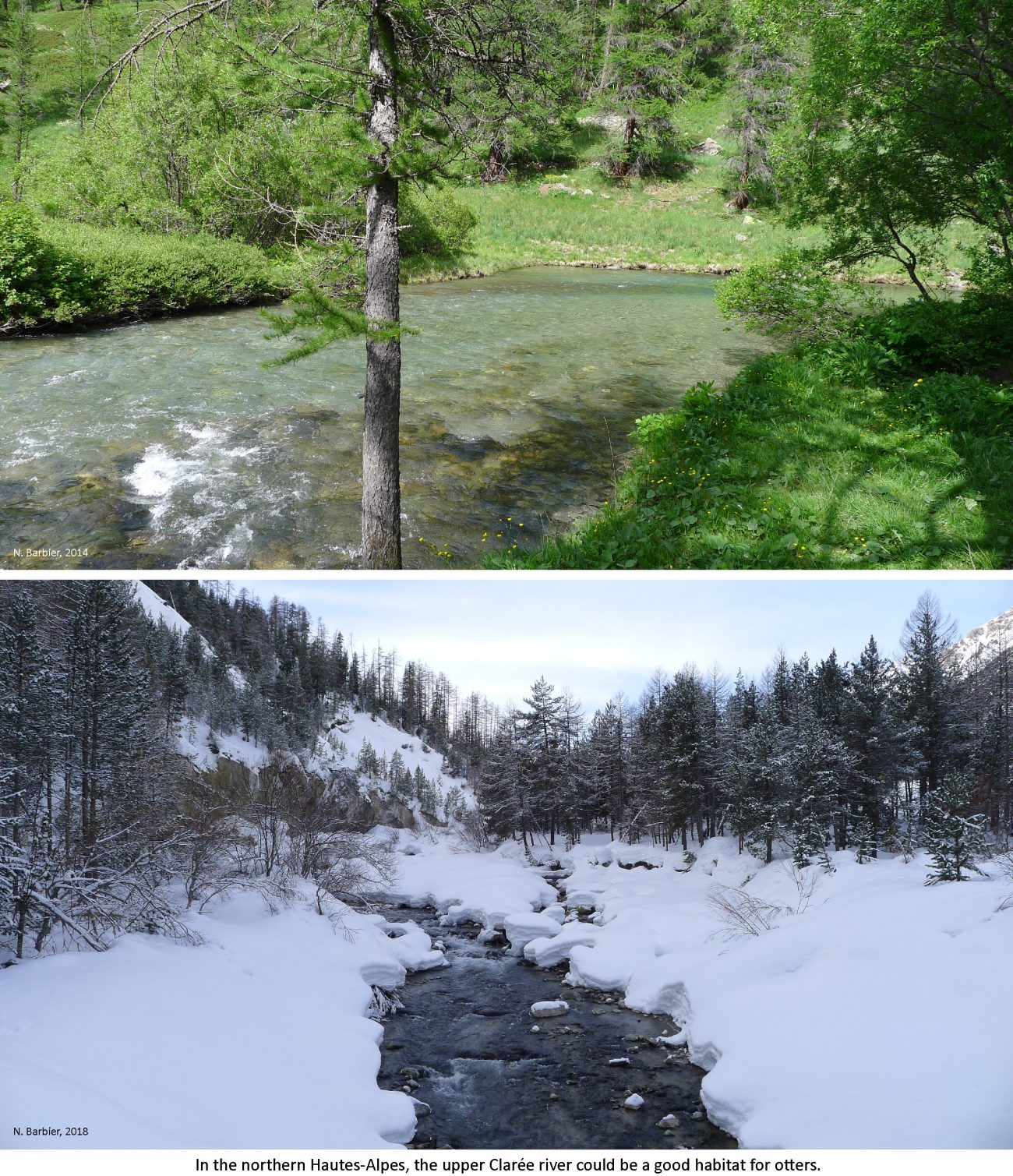 In France, killing an otter is prohibited. In the southern French Alps, no restoration plan has been undertaken despite an acute need for it (photos 16). Restoring abundant otter populations and protecting their habitat would be appropriate for two reasons: the renewal of their population is slow and they are still affected by harmful human impacts (Rigaux, 2013, p.5-7; Parc national des Ecrins, 2017).
In France, killing an otter is prohibited. In the southern French Alps, no restoration plan has been undertaken despite an acute need for it (photos 16). Restoring abundant otter populations and protecting their habitat would be appropriate for two reasons: the renewal of their population is slow and they are still affected by harmful human impacts (Rigaux, 2013, p.5-7; Parc national des Ecrins, 2017).
Photos 17
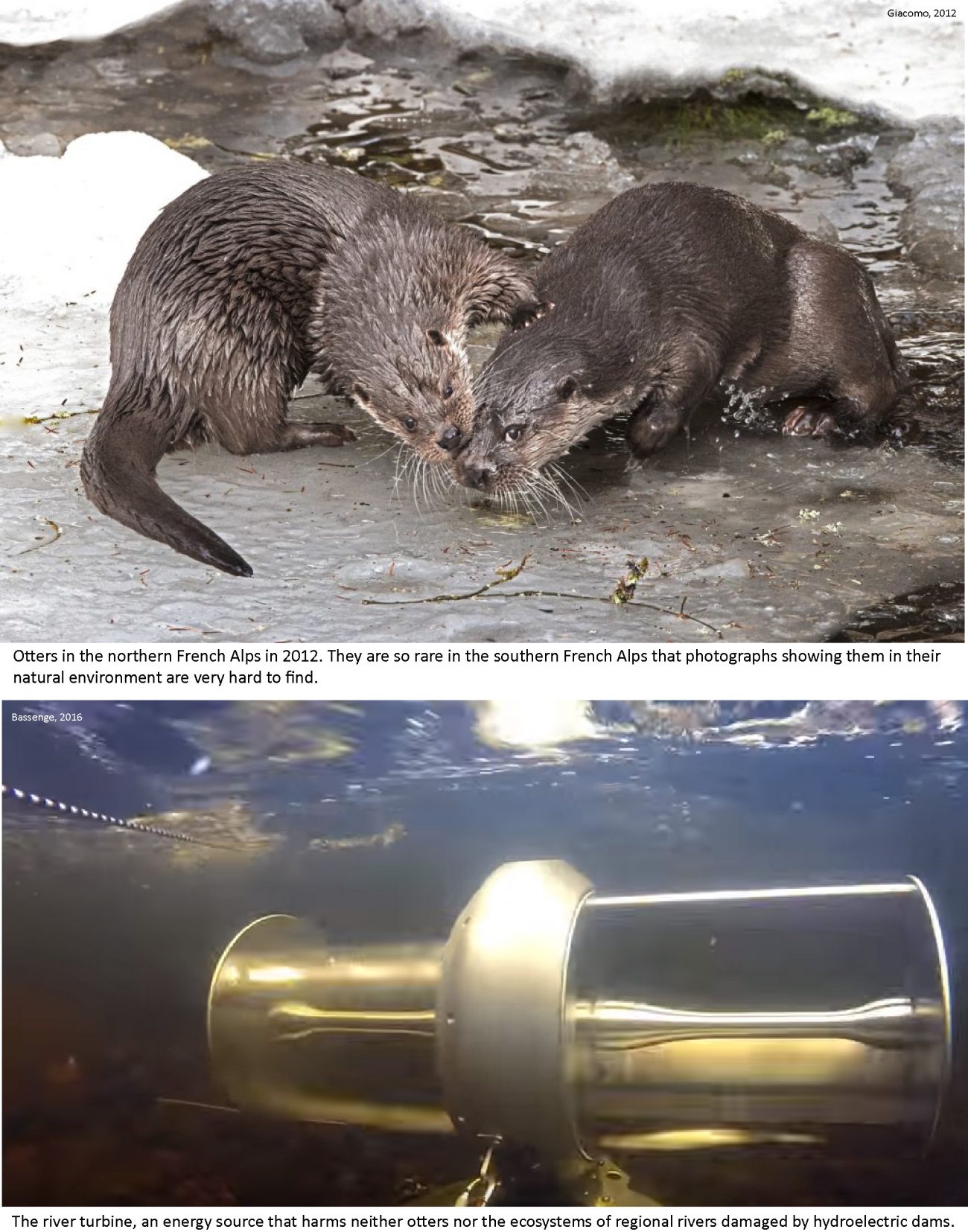 There are more than 40 dams in the Hautes-Alpes. They have either damaged or eliminated a substantial part of otter habitat in this département. Although otters can live in dam reservoirs, these places are nothing like ideal habitat, in part because they usually make it harder for them to find good resting places. Otters would benefit from an energy transition plan that would minimize the regional dependency on electricity from hydro dams. Local elected officials and legislators who represent the Hautes-Alpes at the French parliament neglect major alternatives to dams: river turbines are particularly relevant in mountainous areas (photos 17). Despite being the most privileged French region in terms of yearly hours of sunshine and potential for growth in solar power (countless south-facing roofs and slopes), solar energy provides less than 5 percent of the total electricity consumption in the Région Sud. Both the multiplication of river turbines and a huge development of solar power are possible in this region in the short run. In conjunction with the breaching of dams, such a rapid energy transition would be beneficial to otters, numerous river ecosystems and us (Cerema, 2017, p.6; Idénergie, 2018; Ministère de l’Ecologie, de l’Energie, du Développement Durable et de la Mer [EEDDM], 2009, p.17-19; Rigaux, 2013, p.5-7; RTE, 2017, p.6, 19).
There are more than 40 dams in the Hautes-Alpes. They have either damaged or eliminated a substantial part of otter habitat in this département. Although otters can live in dam reservoirs, these places are nothing like ideal habitat, in part because they usually make it harder for them to find good resting places. Otters would benefit from an energy transition plan that would minimize the regional dependency on electricity from hydro dams. Local elected officials and legislators who represent the Hautes-Alpes at the French parliament neglect major alternatives to dams: river turbines are particularly relevant in mountainous areas (photos 17). Despite being the most privileged French region in terms of yearly hours of sunshine and potential for growth in solar power (countless south-facing roofs and slopes), solar energy provides less than 5 percent of the total electricity consumption in the Région Sud. Both the multiplication of river turbines and a huge development of solar power are possible in this region in the short run. In conjunction with the breaching of dams, such a rapid energy transition would be beneficial to otters, numerous river ecosystems and us (Cerema, 2017, p.6; Idénergie, 2018; Ministère de l’Ecologie, de l’Energie, du Développement Durable et de la Mer [EEDDM], 2009, p.17-19; Rigaux, 2013, p.5-7; RTE, 2017, p.6, 19).
In agricultural areas, when irrigation is done without paying enough attention to nearby water bodies, the habitat of otters may dry out every summer and fall. Overgrazing by sheep (mostly) and cattle is highly detrimental to otters. Water is contaminated by their excrements. Unprotected banks are damaged by their trampling. Shallow waters open to sheep and cattle are severely degraded as well. Mostly thanks to their topography, much of the southern French Alps is spared from other adverse agricultural impacts like nitrates and pesticides. Only a few water bodies are contaminated (Comité de bassin Rhône-Méditerranée, 2013, p.169; Département des Hautes-Alpes, 2016; Ministère EEDDM, 2009, p.17-19; Rigaux, 2013, p.5-7).
On top of all these man-induced hardships otters are put through, lots of fishermen do not like them. These fishermen accuse them of eating too much… fish. Because otters need resting places, organizers of whitewater kayaking, canoeing, rafting and the like should refrain from using certain portions of rivers.
In spite all of their torments, otters have one advantage: nobody is afraid of them. When fear comes into play, that’s another story…
Extermination welcomed by the majority
The last bear of the French Alps was probably killed in the Hautes-Alpes near Orcières in 1895. If bears were to return to the French Alps, how many inhabitants of the French Alps and elected officials would see them as a sort of « wild terrorists »?
In the eastern Hautes-Alpes, the 82-square-kilometer area of the municipality of Ristolas welcomes large sheep herds every summer. None of its resident has ever seen a bear strolling between herds of sheep. So who is going to ponder over the massive bear depicted on the century-old municipal heraldry? Who is going to reflect upon the various regional places (visible on hiking maps) named after the extirpated ursidae (Fédération française de randonnée pédestre, 2016)?
The fear caused by bears among human beings may be their worst enemy. Deadly attacks attributed to Eurasian brown bears are rare. Consider Scandinavia (Norway and Sweden) where bears have been common for ages. According to estimates made in 1850, there were between 4,000 and 5,000 of them in an area nearly twice bigger than France. From 1750 to 1962, 27 people were said to be killed by bears, that is one death every 8 years (Swenson et al., 1999).
So, OK, Eurasian brown bears can be dangerous to human beings. It does not give us the right to bar them from living in areas with low human population densities where the risk of deadly attack is extremely low. In Croatia, which is home to 600 to 1,000 bears (for the most part in the Dinaric Alps), only one fatal accident occurred between 1945 and 2007. For many, one death in 62 years is not acceptable (Mercier, 2007; Pays de l’ours, 2018).
Anti-bear people also focus on bear attacks on sheep and cattle. As it turns out, their impact is even more trifling than that of wolves. It is well compensated too. On the French side of the Pyrénées mountain range which straddles the France-Spain border, there are about 30 bears old enough to hunt. On average, each of them kills less than 3 sheep per year. On average, sheep producers get 250 euros for a sheep confirmed killed by a bear. No less than 570,000 sheep spend the summer on the French side of the Pyrénées. Sheep and cattle producers repeatedly pretend to be saddened by their loss due to bears. They like to show pictures of sheep half devoured on the media or social networks. Oddly enough, they seem much less saddened by the hundreds of thousands of sheep that they take every year to French slaughterhouses where they are cut into pieces (Pays de l’ours, 2012; Préfet région Occitanie, 2016).
The fear of being killed by a bear is far out of proportion to the risk; the killings of sheep and cattle are almost anecdotal. It doesn’t matter to French anti-bear people. They keep hanging on to these senseless excuses in order to confine a few dozen bears in a small part of the Pyrénées.
Let’s have a look at what goes on among our European neighbors. In some areas of the eastern European Alps, bears are doing well. In Slovenia for instance, 500 protected bears roam a few thousand square kilometers of mountainous forests and meadows. Even small-scale reintroduction plans can bring rapid positive results. Ten bears were reintroduced in Trentino (Italian Alps) between 1999 and the early 2000s where they benefit from a rather safe haven (photo 18). Trentino shares similarities with the Hautes-Alpes in terms of population density, tourism, climate and ecosystems. In 2017, the bear population reached nearly 60 in this small portion of the Italian Alps, with 3.3 bears for every 100 km² of land (Pays de l’ours, 2018; Provincia autonoma di Trento, 2018, p.8, 18; Trentino, 2018).
Photo 18
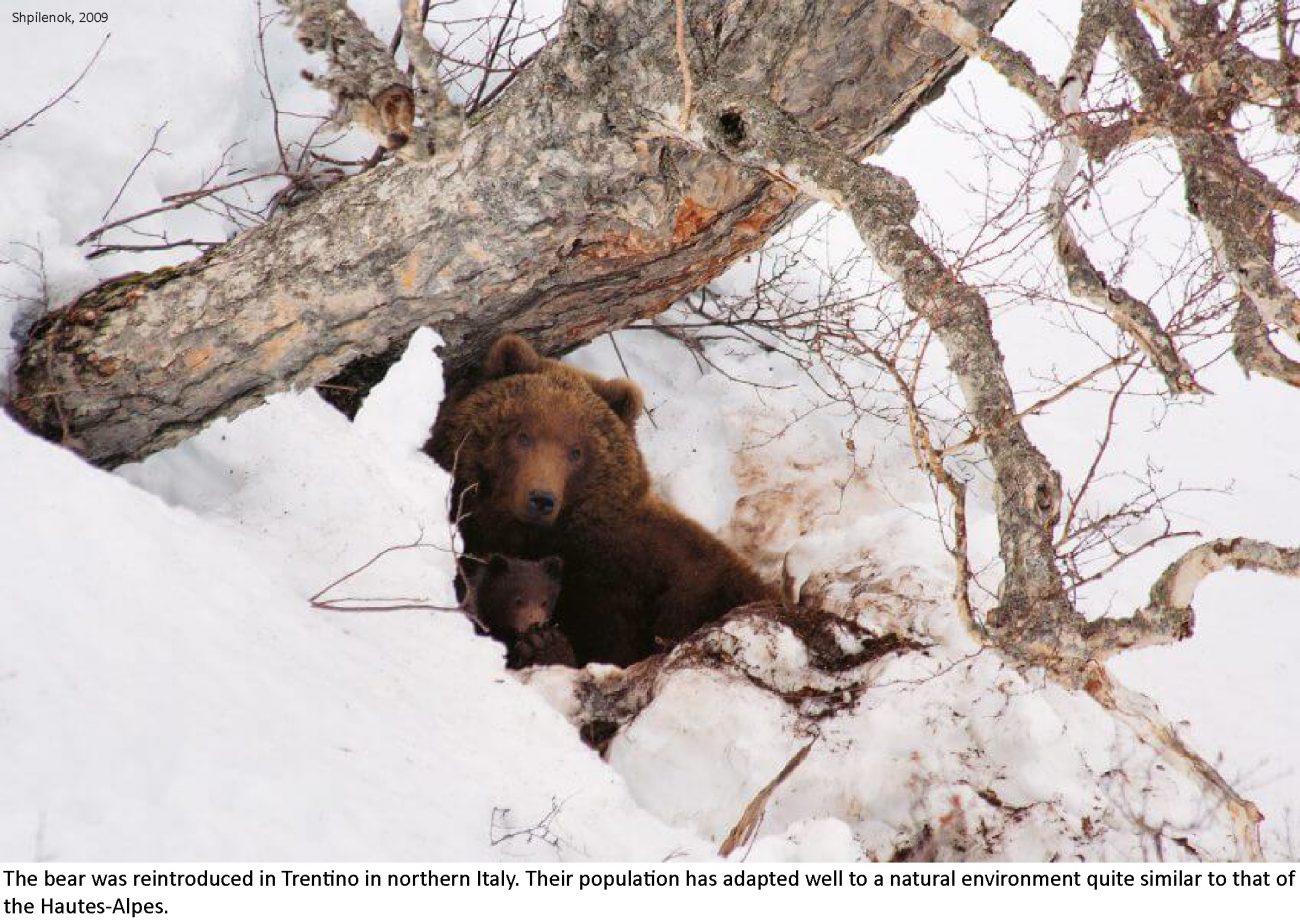 In order for bears to be reintroduced in the Hautes-Alpes, the least populated and developed areas should obviously be targeted. In that regard, Champsaur (western Ecrins), northern Queyras around Abriès and Ristolas would be suitable, along with contiguous areas (Isère within the Ecrins near Champsaur; Haut-Ubaye and Italy, respectively south and east of Queyras) (satellite images 1 and photos 19). Put together, these areas could probably take in as many bears as Trentino.
In order for bears to be reintroduced in the Hautes-Alpes, the least populated and developed areas should obviously be targeted. In that regard, Champsaur (western Ecrins), northern Queyras around Abriès and Ristolas would be suitable, along with contiguous areas (Isère within the Ecrins near Champsaur; Haut-Ubaye and Italy, respectively south and east of Queyras) (satellite images 1 and photos 19). Put together, these areas could probably take in as many bears as Trentino.
Photos 19
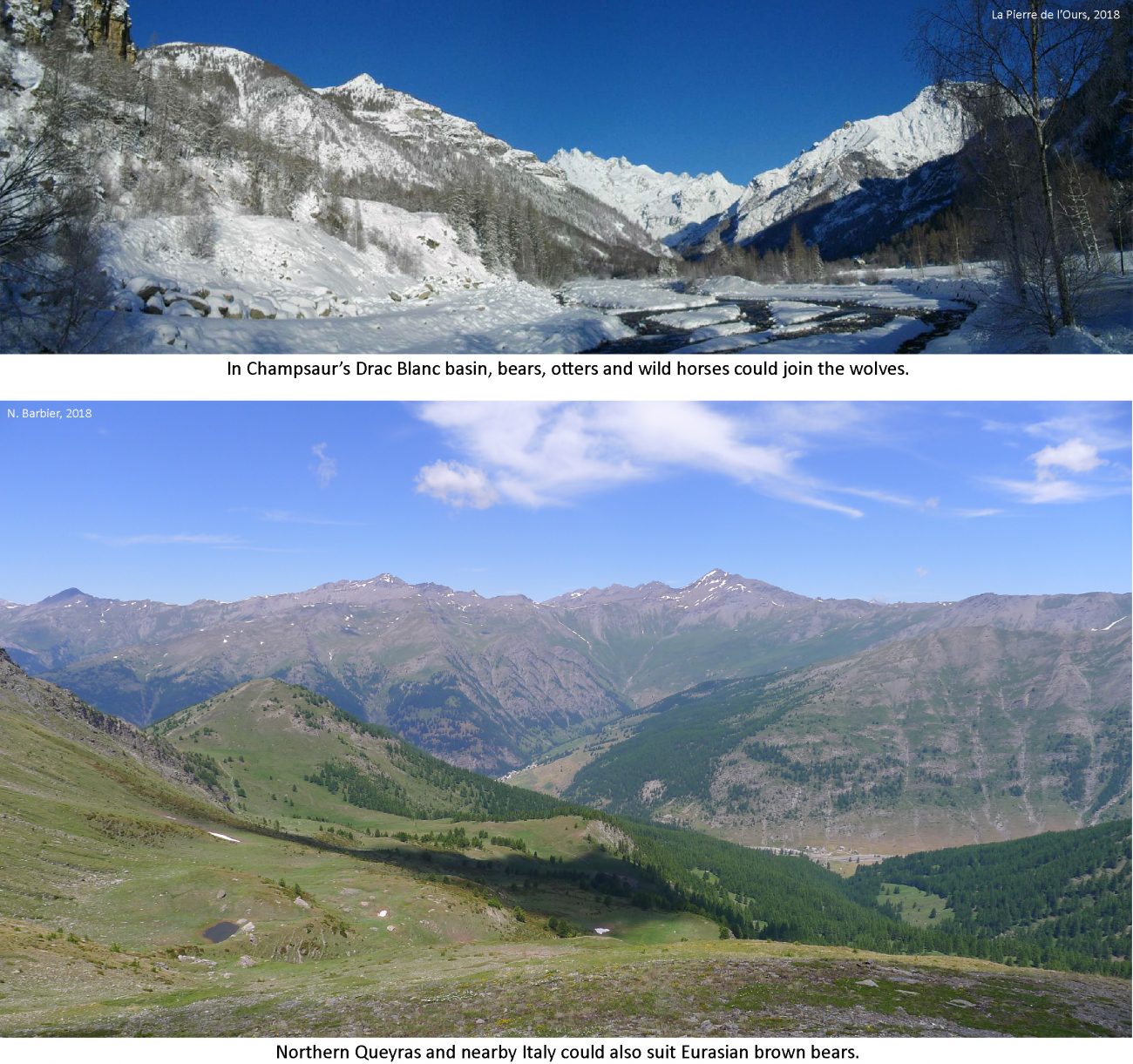 With good reintroduction plans, perhaps 300 bears could live in the French Alps by 2050. With comparable efforts in other French mountain ranges (Jura, Massif Central, Pyrénées, Vosges), we could have 1,000 bears or more in France. Even then, bear population density in France would remain far from that of Romania. 6,000 bears are concentrated on a mountainous one-fourth of this country. The French and Romanian mountains are a lot different in terms of development and tourism. However, the situation in Romania demonstrates that relatively high bear populations are compatible with low human population densities, as is the case in wide swaths of the French Alps (Romania Dacia, 2016; Şelaru et al., 2017).
With good reintroduction plans, perhaps 300 bears could live in the French Alps by 2050. With comparable efforts in other French mountain ranges (Jura, Massif Central, Pyrénées, Vosges), we could have 1,000 bears or more in France. Even then, bear population density in France would remain far from that of Romania. 6,000 bears are concentrated on a mountainous one-fourth of this country. The French and Romanian mountains are a lot different in terms of development and tourism. However, the situation in Romania demonstrates that relatively high bear populations are compatible with low human population densities, as is the case in wide swaths of the French Alps (Romania Dacia, 2016; Şelaru et al., 2017).
Satellite images 1
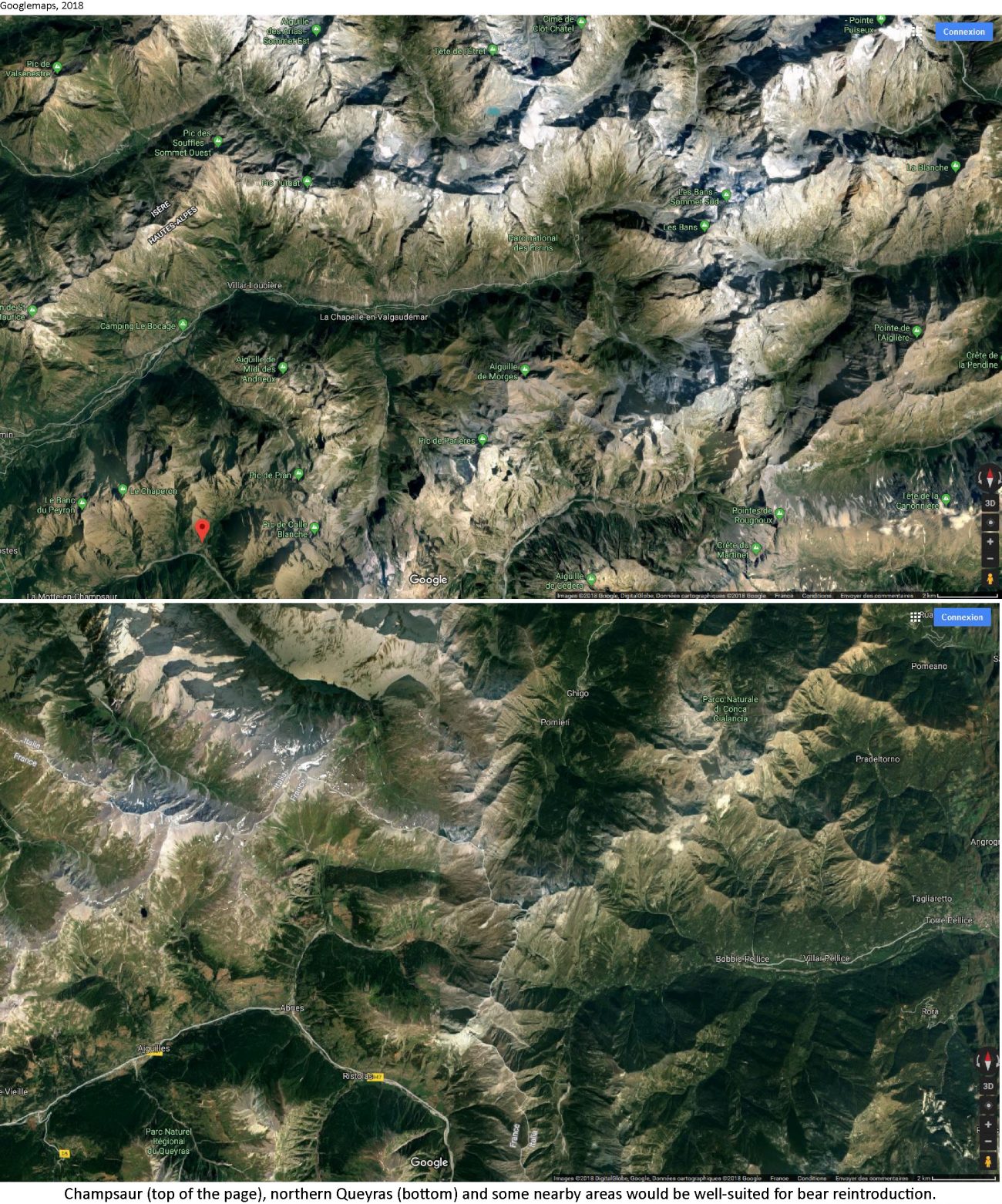 What additional arguments could anti-bear people come up with to vilify their wild « enemy »? Trails for cross-country and downhill skiing meander along constricted strips of land. Most of them are used one-third of the year. Bears would not build their dens there. Some skiing areas used in May and June in wildlands would have to be abandoned so as not to encroach on critical bear habitat. What else? The peak of the summer tourist season spans over July and August. During the summer, it would not be difficult for bears to find quiet places away from popular trails or climbs. Indeed, people hardly ever wander in many portions of small upper valleys rich in biodiversity (including game).
What additional arguments could anti-bear people come up with to vilify their wild « enemy »? Trails for cross-country and downhill skiing meander along constricted strips of land. Most of them are used one-third of the year. Bears would not build their dens there. Some skiing areas used in May and June in wildlands would have to be abandoned so as not to encroach on critical bear habitat. What else? The peak of the summer tourist season spans over July and August. During the summer, it would not be difficult for bears to find quiet places away from popular trails or climbs. Indeed, people hardly ever wander in many portions of small upper valleys rich in biodiversity (including game).
Just like Eurasian brown bears, wild horses cannot live in habitats suitable for them in the French Alps. Has the return of this species even crossed the mind of self-proclaimed wildlife enthusiasts living in the Hautes-Alpes?
Land of pony trekking
If the Hautes-Alpes’ 260,000 sheep vacated 80 percent of the meadows they degrade every summer, wild horses could graze there. So too could chamois and Alpine ibexes whose habitats have been drastically shrunk by sheep. Open forests rich in forage are also good habitats for wild horses, chamois and Alpine ibexes. At the moment, herds of wild horses galloping over the mountains can only be the figment of our imagination. In France, such a sight is illegal (ONCSF, 2013).
Between 7,000 and 11,000 years ago, wild horses inhabited the lands of the present-day Hautes-Alpes. Before the widespread domestication of horses, local people used to eat wild horses’ meat. In today’s Europe, wild or semi-wild horses are confined to small mountainous areas. Most species adapted to mountainous lands live in Spain and the Balkans. Species like the Asturcon and Pottoka from northern Spain or the Hutzul from the Carpathian mountains of eastern Europe could adapt to the Hautes-Alpes and be used in the context of reintroduction plans (photo 20). If well done, by 2050 reintroduction could result in a few thousand wild horses in this département alone and tens of thousands in the French Alps as a whole (Erenow, 2018; Horsetalk, 2015; Rewilding Europe, 2012).
Wild horses can thrive in mountainous meadows and open forests, whether or not they are rich in nutrients. Where nutrients are plentiful, Alpine ibexes, chamois and other ungulate species tend to reduce the height of vegetation to the size preferred by wild horses. In nutrient poor ecosystems, wild horses can feed mostly on poor or dead grasses. By eliminating these grasses, they stimulate regrowth for the benefit of chamois, Alpine ibexes and other ungulates (Rewilding Europe, 2014, p.11).
In ecological terms, the restoration of abundant wild horse populations would be logical. The environmental impacts of wild horses, Alpine ibexes, chamois and other ungulates are lesser than those of sheep which devastate a big chunk of regional alpine meadows every year. There are two reasons for this lesser impact, plus a third one when wildlife is respected:
- In most cases, the concentration of sheep is higher than that of wild herds.
- Sheep often leave less vegetation than wild herds after grazing.
- If predator populations (bears, lynxes, wolves, etc.) are as consistent as possible with the preys available, they decrease even further the environmental impacts of wild horses, chamois, Alpine ibexes and other ungulates.
Photo 20
From an economic perspective, what could be expected from a respected, varied and abundant wildlife, including large predators? Scores of tourists would probably come to watch it. Sightseeing tours respectful of wild animals and their habitats could be organized for wild horses, wolves, otters and bears. The region could draw substantial revenues from this activity.
At the same time, why not develop and implement a regional plan to sell the meat of wild boars, chamois and other wild ungulates? As long as hunt quotas are set to maintain abundant populations in the long run and sanitary measures are strictly enforced, the sale of wild meat would have two beneficial effects. First, it would create quite a few sensible jobs (e.g., in hunting, monitoring of wild populations, meat preparation, sanitary control). Second, consumers could buy high quality meat in local butcheries and restaurants. By doing so, they would eat less meat from domesticated animals. Perhaps more importantly, they would reduce the adverse environmental impacts of livestock production. It would mean less lands set aside for pastures and livestock feed, less methane (a potent greenhouse gas) released by cattle into the atmosphere, less overgrazed areas and related water pollution.
In the end, what is the primary reason for the absence or near extinction of formerly abundant or common wild animals? In the Hautes-Alpes like elsewhere in the world, it is the majority population’s lack of interest, indifference, contempt or hatred for them.
Regardless of their political affiliation, most of these people believe that they should dominate non-human life forms and sometimes the environment as a whole. Their inclination to dominate may encompass all or parts of wildlife and immense aquatic, forest, prairie and mountain ecosystems. So they usually try to subject wildlife to their laws. Considering the opposite situation on a regular basis requires foresight and humility. The majority population clearly refuses to consider it.
In doing so, individuals who belong to this majority not only display their arrogance towards non-human life forms. They also deny or downplay a fundamental part of their identity as human beings: our role to maintain long-term balanced relations between our species and the rest of life on Earth, be it modified by human activity (e.g., a logged forest) or untouched (e.g., old-growth forest), domesticated (e.g., farm animals) or wild (e.g., chamois).
If individually and collectively we do not live up to our role as human beings, whether to make profits or not, we are doomed to perpetuate a deeply unhealthy situation. It can manifest itself as a pervasive malaise. If a large majority of people do not live up to their role, we expose ourselves to self-destruction. If most Hauts-Alpins did live up to their role, then wild horses, wolves, otters and bears would either be abundant or very common in their département.
Overall, right-wing supporters are probably more cruel to wildlife than leftists. But this is not the most crucial issue. Indeed, leftists tend to rank their human rights on the top of their hierarchy. It does not mean that we should call into question the universal declaration of human rights among other international texts dealing with human rights. The rights laid out in the declaration are valid. However, current texts on human rights habitually do not mention at all or in any meaningful way our relations with non-human life forms. Yet, our species is entirely dependent upon these life forms. Therefore, only when these official texts on human rights explicitly address our relations with non-human life forms as a core content may they be considered enlightened. And in order to be enlightened, they need to clarify the role of human beings as responsible for a genuine balance within the living world as a pillar of our identity.
Deprogramming human arrogance towards non-human life forms would help us find our place in the world.
Sources
Agreste PACA, 2018. Mémento de la statistique agricole, de la forêt et des industries agroalimentaires. 1/8/2018.
Agreste, 2010. Portrait agricole : les Hautes-Alpes. 16/5/2018.
Barbier, N., 2014. La cogestion intergouvernementale du Loup Gris au Nord des Rocheuses : L’exemple de l’Etat d’Idaho. In Jean-Marc Moriceau, Vivre avec le loup ? Trois mille ans de conflits, Editions Tallandier, pp.437-448. 30/7/2018.
Cerema, 2017. Le photovoltaïque. 17/9/2018.
Comité de bassin Rhône-Méditerranée, 2013. Etats des lieux 2013. 18/9/2018.
Département des Hautes-Alpes, 2016. Suivi de la qualité des eaux superficielles – Réseau Complémentaire Départemental – Rapport 2016. 18/9/2018.
DREAL Auvergne-Rhône-Alpes, 2018 [a]. Données sur les dommages du 1er janvier au 31 décembre 2017. 1/8/2018.
DREAL Auvergne-Rhône-Alpes, 2018 [b]. Victimes indemnisées au 31 décembre 2017. 1/8/2018.
Enault N. et Rasplus J., 2017. Territoire, attaques de troupeaux, bêtes abattues… Trois données pour comprendre la présence du loup en France. France Info. 1/8/2018.
Erenow, 2018. The domestication of the horse and the origins of riding The tale of the teeth. 23/8/2018.
Fédération française de la randonnée pédestre, 2016. La Traversée des Alpes – De la Maurienne à l’Ubaye. Chapitre « Les mammifères disparus ».
Horsetalk, 2015. A wild idea? Should horses be returned to their historic rangelands. 23/8/2018.
Idénergie, 2018. Une source d’énergie continue. Profitez des avantages de l’hydrolienne. 30/7/2018.
IGN, 2015. Résultats d’inventaire forestier – Résultats standards – Les résultats : Hautes-Alpes. 18/9/2018.
Insee, 2016. Populations légales en vigueur à compter du 1er janvier 2017. 24/8/2018.
Irstea et al., 2016. 3000 alpages/estives dans le massif des Alpes. 18/9/2018.
IUCN, 2015. Lutra lutra. 18/9/2018.
LPO, 2017. Découverte de la Loutre d’Europe dans les Hautes-Alpes! 30/7/2018.
Mercier J. P., 2007. Jean Paul Mercier : L’Ours et l’homme : Interaction et Cohabitation en Europe de l’Ouest. La buvette des alpages. 31/7/2018.
Mines-Paristech, 2013. Loup et pastoralisme, cohabitation impossible ? 1/8/2018.
Ministère de l’Ecologie, de l’Energie, du Développement Durable et de la Mer, 2009. Plan National d’Actions pour la Loutre d’Europe (Lutra lutra), 2010-2015. 30/7/2018.
Ministère de la transition écologique et solidaire, 2018. Plan national d’actions 2018-2023 sur le loup et les activités d’élevage. 30/7/2018.
ONCSF, 2013. Les ongulés de montagne en France – Situation en 2010. 25/8/2018.
Parc national des Ecrins, 2017. Le retour de la loutre confirmé en Oisans. 17/9/2018.
Pays de l’ours, 2018. Succès et déclins dans les Balkans. 31/7/2018.
Pays de l’ours, 2012. La mortalité des brebis dans les Pyrénées et l’incidence de l’ours brun. 1/8/2018.
Préfet région Occitanie, 2016. Comparatif des dommages annuels depuis 2006 et effectif minimum d’ours détectés. 1/8/2018.
Provincia autonoma di Trento, 2018. Rapporto – Grandi carnivori 2017. 1/8/2018.
Rewilding Europe, 2014. Rewilding horses in Europe. 20/9/2018.
Rewilding Europe, 2012. Where did the wild horse go? 23/8/2018.
Rigaux P., 2013. Faune – PACA Publication n°35 – Répartition et statut de la Loutre d’Europe (Lutra lutra), du Campagnol amphibie (Arvicola sapidus) et du Castor d’Eurasie (Castor fiber) en PACA. 30/7/2018.
Romania Dacia, 2016. Bears in Romania. 23/8/2018.
RTE, 2017. Bilan électrique et perspectives 2016 – Provence-Alpes-Côte d’Azur. 17/9/2018.
Şelaru N. et al., 2017. A successful management of the bear population in Romania. 23/8/2018.
Sordello R., 2013. La loutre d’Europe. Museum national d’histoire naturelle. 18/9/2018.
Swenson J. et al., 1999. Interactions between brown bears and humans in Scandinavia. Biosphere conservation, 2-1. pp.1-9. 31/7/2018.
Trentino, 2018. Holidays in Trentino. 1/8/2018.
ventdouxprod 2018, all rights reserved
Footnotes
[1] Among other municipalities, this is also the case for Abriès (77 km² with 4 inh./km²), Réallon (72 km² ; 4 inh./km²), Ristolas (92 km² ; 1 inh./km²), Villar-d’Arêne (77 km² ; 4 inh./km²), etc. (Insee, 2016).
[2] Fish is the main component of the otters’ diet. They also feed on amphibians, insects, crustaceans, etc.

